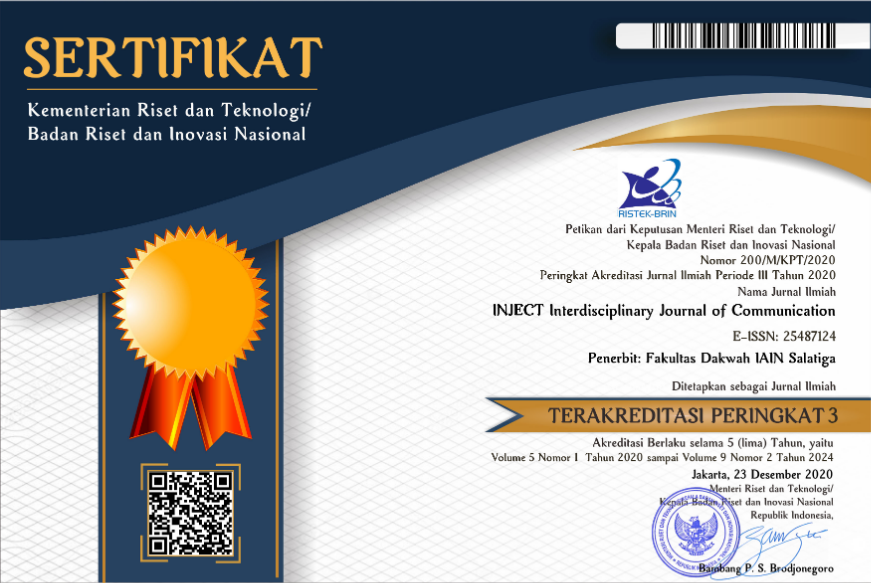Cultural Branding of Pesilat Village Madiun Regency at the Youth Tourism and Sport Office
Abstract
Madiun Regency has a high potential culture, that is “Pencak Silat”. It’s evidenced by the existence of 14 silat colleges in Madiun Regency. For some people, “Pencak Silat” and fighters have negative impression because in their opinion they did disturbance. Through the formation of “Kampung Pesilat” , the government of Madiun district through youth and sport tourism office of Madiun Regency aims to remove the negative stigma about “Pencak Silat” while lifting the potential of “Pencak Silat” as an icon of the cultural branding Madiun Regency. The purpose of this research is to know the cultural branding of “Kampung Pesilat” implemented by youth and sport tourism office of Madiun Regency. The type of research used is qualitative descriptive by making factual description according to the data obtained in the field. Researcher gathers the datas using depth interview techniques, online interview, field observations, and documentation. Researcher conducted interview with related person that are youth and sports tourism office of Madiun Regency, Ikatan Pencak Silat Indonesia, and several people in Madiun Regency. The process of analysis is done by using the Brand Destination theory of Ristianto which includes Brand Culture, Brand Character, Brand Personality, Brand Name, Brand Logo and Symbols, Brand Slogan. The result of this study shows the Government of Madiun through youth and sports tourism office of Madiun Regency in carrying out cultural branding of “Kampung Pesilat” has been running and fulfilling aspects of the Brand Destination theory, although the implementation is still not maximal.
Keywords
Full Text:
PDFReferences
Bungin, B. (2015). KOMUNIKASI PARIWISATA: Pemasaran dan Brand Destinasi. Jakarta: Kencana.
Efendy, O. U. (2006). Hubungan Masyarakat: Suatu Studi Komunikasi. Bandung: Remaja Rosdakarya.
Ismayanti. (2004). Pengantar Pariwisata. Jakarta: Grasindo.
Kotler, P. (2006). B2B Brand Management. Jakarta: Bhuana Ilmu Populer.
Kriswanto, E. S. (2015). Pencak Silat. Yogyakarta: Pustaka Buku Press.
Kriyantono, R. (2006). Teknik Praktis Riset Komunikasi. Jakarta: Kencana Prenada Media Group.
Nurjaman, K. (2012). Komunikasi Public Relations. Bandung: CV Pustaka Setia.
Paramita, S. (2017). Lokal Perspektif Komunikasi Pariwisata Masyarakat Di Desa Sade Lombok. Jurnal Visi Komunikasi, 14.
Prameswari, N. S., Suharto, M., & Wulandari, E. (2018). Strategi Branding Melalui Inovasi Desain Kemasan Bagi Home Industry Sabun Cair. Desain Komunikasi Visual, Manajemen Desain Dan Periklanan (Demandia), 3(2).
Puspita, D., Adhrianti, L., & Gushevinalti. (2018). Strategi Komunikasi Pariwisata Kota Bengkulu Studi Unique Selling Proposition Program Visit 2020 Wonderful Bengkulu. Communication Spectrum, 8(1).
Ristianto, M. (2005). The Role Of Destination In The Tourism Stakeholders System (The Campi Flegrei Case). University of Naples Federico II.
Sari, N. C. I. (2019). Analisis Strategi Branding Desa Paringan Kecamatan Jenangan Kabupaten Ponorogo Guna Mengurangi Citra Negatif Sebagai Kampung Gila.
Tjiptono, Fandi. (2006). Pemasaran Jasa. Malang: Bayumedia Publishing.
Tjiptono, Fandy. (2007). Strategi Pemasaran. Yogyakarta: Penerbit Andi.
Werdihartohadi, F. A. (2011). Menjadi Pesilat. Jakarta: Be Champion.
DOI: https://doi.org/10.18326/inject.v6i2.143-158
Refbacks
- There are currently no refbacks.
Copyright (c) 2021 Ahmad Nur Said

This work is licensed under a Creative Commons Attribution 4.0 International License.









